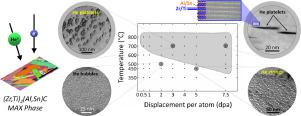当前位置:
X-MOL 学术
›
Acta Mater.
›
论文详情
Our official English website, www.x-mol.net, welcomes your feedback! (Note: you will need to create a separate account there.)
In situ He+ irradiation of the double solid solution (Ti0.5,Zr0.5)2(Al0.5,Sn0.5)C MAX phase: defect evolution in the 350-800 °C temperature range
Acta Materialia ( IF 9.4 ) Pub Date : 2021-03-01 , DOI: 10.1016/j.actamat.2020.116606 B. Tunca , G. Greaves , J.A. Hinks , P.O.Å. Persson , J. Vleugels , K. Lambrinou
Acta Materialia ( IF 9.4 ) Pub Date : 2021-03-01 , DOI: 10.1016/j.actamat.2020.116606 B. Tunca , G. Greaves , J.A. Hinks , P.O.Å. Persson , J. Vleugels , K. Lambrinou

|
Thin foils of the double solid solution (Zr0.5,Ti0.5)2(Al0.5,Sn0.5)C MAX phase were in situ irradiated in a transmission electron microscope (TEM) up to a fluence of 1.310 ionscm (7.5 dpa), using 6 keV He ions. Irradiations were performed in the 350-800 °C temperature range. In situ and post-irradiation examination (PIE) by TEM was used to study the evolution of irradiationinduced defects as function of dose and temperature. Spherical He bubbles and string-like arrangements thereof, He platelets, and dislocation loops were observed. Dislocation loop segments were found to lie in non-basal-planes. At irradiation temperatures ≥ 450 °C, grain boundary tearing was observed locally due to He bubble segregation. However, the tears did not result in transgranular crack propagation. The intensity of specific spots in the selected area electron diffraction patterns weakened upon irradiation at 450 and 500 °C, indicating an increased crystal symmetry. Above 700 °C this was not observed, indicating damage recovery at the high end of the investigated temperature range. High-resolution scanning TEM imaging performed during the PIE of foils previously irradiated at 700 °C showed that the chemical ordering and nanolamination of the MAX phase were preserved after 7.5 dpa He irradiation. The size distributions of the He platelets and spherical bubbles were evaluated as function of temperature and dose.
中文翻译:

双固溶体 (Ti0.5,Zr0.5)2(Al0.5,Sn0.5)C MAX 相的原位 He+ 辐照:350-800 °C 温度范围内的缺陷演变
在透射电子显微镜 (TEM) 中原位辐照双固溶体 (Zr0.5,Ti0.5)2(Al0.5,Sn0.5)C MAX 相的薄箔,达到 1.3×10 离子的通量Øcm (7.5 dpa),使用 6 keV He 离子。辐照在 350-800 °C 的温度范围内进行。TEM 的原位和辐照后检查 (PIE) 用于研究辐照诱导缺陷随剂量和温度的演变。观察到球形He气泡及其线状排列、He片晶和位错环。发现位错环段位于非基面中。在辐照温度 ≥ 450 °C 时,由于 He 气泡偏析,在局部观察到晶界撕裂。然而,撕裂不会导致穿晶裂纹扩展。选定区域电子衍射图中特定点的强度在 450 和 500°C 照射后减弱,表明晶体对称性增加。在 700 °C 以上没有观察到这种情况,表明在研究温度范围的高端处损坏恢复。在先前在 700 °C 辐照的箔片的 PIE 期间进行的高分辨率扫描 TEM 成像表明,MAX 相的化学排序和纳米层压在 7.5 dpa He 辐照后得以保留。He 血小板和球形气泡的尺寸分布被评估为温度和剂量的函数。在先前在 700 °C 辐照的箔片的 PIE 期间进行的高分辨率扫描 TEM 成像表明,MAX 相的化学排序和纳米层压在 7.5 dpa He 辐照后得以保留。He 血小板和球形气泡的尺寸分布被评估为温度和剂量的函数。在先前在 700 °C 辐照的箔片的 PIE 期间进行的高分辨率扫描 TEM 成像表明,MAX 相的化学排序和纳米层压在 7.5 dpa He 辐照后得以保留。He 血小板和球形气泡的尺寸分布被评估为温度和剂量的函数。
更新日期:2021-03-01
中文翻译:

双固溶体 (Ti0.5,Zr0.5)2(Al0.5,Sn0.5)C MAX 相的原位 He+ 辐照:350-800 °C 温度范围内的缺陷演变
在透射电子显微镜 (TEM) 中原位辐照双固溶体 (Zr0.5,Ti0.5)2(Al0.5,Sn0.5)C MAX 相的薄箔,达到 1.3×10 离子的通量Øcm (7.5 dpa),使用 6 keV He 离子。辐照在 350-800 °C 的温度范围内进行。TEM 的原位和辐照后检查 (PIE) 用于研究辐照诱导缺陷随剂量和温度的演变。观察到球形He气泡及其线状排列、He片晶和位错环。发现位错环段位于非基面中。在辐照温度 ≥ 450 °C 时,由于 He 气泡偏析,在局部观察到晶界撕裂。然而,撕裂不会导致穿晶裂纹扩展。选定区域电子衍射图中特定点的强度在 450 和 500°C 照射后减弱,表明晶体对称性增加。在 700 °C 以上没有观察到这种情况,表明在研究温度范围的高端处损坏恢复。在先前在 700 °C 辐照的箔片的 PIE 期间进行的高分辨率扫描 TEM 成像表明,MAX 相的化学排序和纳米层压在 7.5 dpa He 辐照后得以保留。He 血小板和球形气泡的尺寸分布被评估为温度和剂量的函数。在先前在 700 °C 辐照的箔片的 PIE 期间进行的高分辨率扫描 TEM 成像表明,MAX 相的化学排序和纳米层压在 7.5 dpa He 辐照后得以保留。He 血小板和球形气泡的尺寸分布被评估为温度和剂量的函数。在先前在 700 °C 辐照的箔片的 PIE 期间进行的高分辨率扫描 TEM 成像表明,MAX 相的化学排序和纳米层压在 7.5 dpa He 辐照后得以保留。He 血小板和球形气泡的尺寸分布被评估为温度和剂量的函数。

























 京公网安备 11010802027423号
京公网安备 11010802027423号